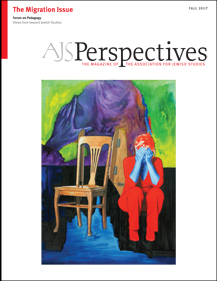Dear Colleagues,
Scouting for a topic for this "Migration Issue" before I migrate out of the AJS presidency, I looked back at columns written by my predecessors. (I trust that readers know that back issues of AJS Perspectives are online.) Our past presidents chose subjects of deep concern to AJS members: access to libraries, the crisis in the academic job market, the promises and challenges posed by open access to our scholarship, the expansion of Jewish Studies, and the disparaging of the humanities. But, rereading these reflections, one subject's absence looms large: teaching.
Having sat through decades of faculty meetings, I should not have been surprised. My department has spent countless hours debating weighty matters—new hires, tenure decisions, curricular changes— and also insubstantial ones. For too many years, use of the copy machine claimed a place on every September's agenda. Oddly, I recall only two instances of department meetings devoted to ideas about the craft of teaching. This reticence to focus on teaching had once extended to our annual AJS conference; not until 2014 did pedagogy become a program division.
Yet, I am convinced that those reading AJS Perspectives care deeply about teaching. If we didn't, we wouldn't have chosen to spend our lives sharing what we have learned with others. When a class goes well, we are pleased; when what we have planned for the day does not, we mull over what went wrong to make certain that the next time we fix it.
Unlike those who teach in elementary and secondary schools, I assume that few of us have ever had formal courses in pedagogy. We have taken classes to master techniques—PowerPoint, Prezi, Blackboard, Chalk, or another cleverly named course management tool. But coursework in subjects that are foundational at schools of education, like educational psychology and instructional strategies, are not part of our training.
Instead, we learned to teach largely through osmosis. Having spent so much time in class on the way to the PhD, we have had countless hours to study many different teachers. Some were excellent. I remember one who was such an extraordinary lecturer that a hundred of us rolled out of bed for an 8:00 a.m. class that was not required for any major. I learned in that classroom that what we were studying mattered deeply to that professor, and that enthusiasm for a subject is infectious.
I also realized that great scholars care deeply about student learning. Surely, I am not the only AJS member to recall a packed classroom with the towering giant of biblical interpretation, Professor Nechama Leibowitz. To this day, I remember not only her masterful teaching but also that she roamed about the room peering over our shoulders to see if we had done our homework.
Great teachers inspire their students, and, as students, we— perhaps unconsciously, perhaps not—absorb and copy their styles. Sometimes, when I hear an advanced graduate student present, I recognize, by cadence and gesture, the dissertation advisor.
I also learned much from teachers who I, regrettably, found boring. I learned not to teach a large undergraduate class sitting at a desk reading from notes or repeating what was assigned in the textbook. I also picked up an invaluable lesson—the necessity for preparation.
When I first started teaching, I naively assumed that, after giving a lecture once or twice, I could breeze into class the next time the topic appeared on the syllabus. But the seemingly effortless teaching that I so prize requires, for me and surely for others, a remarkable investment of time. We know how much preparation a new course requires. But, even when I am teaching something that I have taught many times before, because it has been at least a year since I had given that lecture, orchestrated that discussion, thought about those readings, before I walk into the classroom, I must think through anew the objectives and the pacing of the class. Then there is the additional effort spent to adapt courses in my current stable: changing readings, bringing in new technologies, cutting a lesson that did not work, and inventing new assignments.
Syllabus crafted, notes organized, assignments drafted, I am ready to greet a new class. Knowing that I will have to master dozens of names in a few weeks, I also wonder: Who are these students? When and where were they born? Where do they stand in the world? The annual Beloit College Mindset List, a witty inventory that I recommend if you have never read it, reminds me that, for this generation, TV screens kept getting smaller; for mine, they got larger. Today's students "chat," but mostly without talking. They have little use for roadmaps; they have always had GPS, and Google has always been a verb. These quirky insights into their world provide crucial cultural information. They remind me that my contextual touchstones are likely inscrutable to my students.
I realize that masterful teaching leaves behind no article to send to colleagues, no book to display on our shelves, no citations to track in our peers' work. Since only some of us train students for careers that follow in our footsteps, the legacy of our successful teaching is ephemeral, hidden in our students' memories. Perhaps that explains the disinclination among scholars to spend too much time discussing what happens in the classroom.
As my term as AJS president ends, I thank our members—my teachers, my peers, and my students—for leading our learned society these past two years; and I look forward to having more time for conversations with you about our scholarship and our teaching.
Pamela S. Nadell
American University

